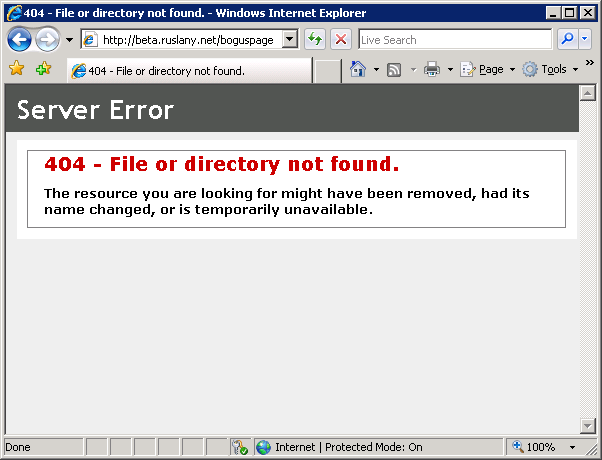What is 404 error?
A 404 or 404 not found error is an HTTP response code. When you visit a website, your computer which is the client, communicates to the server using Hypertext Transfer Protocol. When the server is unable to locate or find the resource which the client asked for it returns an error 404 page not found.
You should not misinterpret 404 error for “Server Not Found error” because in that case, the connection to the server is not made. The most common occurrence of 404 error page is when a user clicks on a dead or broken link.

What causes 404 Error Page?
Whenever the destination server is unable to retrieve a requested resource, it returns an “HTTP 404 – File not found” error. The most common causes of this error are as follows:
- Redesigning a website.
- The file requested is removed or moved to some other location.
- Resource is temporarily unavailable due to site maintenance.
- Moving a webpage from https to HTTP or vice versa.
- The resource doesn’t exist.
- Spelling mistakes in the URL which are internally or externally linked.
How To Find Broken Links on Your Site?
As a webmaster, you must regularly check your website for the presence of any broken or dead links. If you do not want to incur the wrath of your visitors, you must look forward to providing them with a hassle-free user experience.
Chances are that when a user visits your website, he/she might come across 404 error pages, which may be due to broken links or the user might even enter an incorrect URL. Whatever may be the reason, you must take care to keep them grip on your site.
As most people who encounter a 404 error page tend to leave your website, increasing your overall bounce rate.
Here are some tools that can help you identify broken links on your website-
- Google Webmaster Tools: GWT is one of the best ways to find broken links. You need to set up and verify a webmaster account for this purpose. To find broken or missing links open the ‘Dashboard’ and navigate to Diagnostics > Crawl Errors and then you can find the missing links after choosing the “not found” option. This tool is beneficial as it also tells you where the broken link comes from in case of an external broken link.
- You can use free tools like Xenu’s Link Sleuth, Screaming Frog, etc. which are tools/programs that crawl your website’s links, images, CSS etc to find and report any broken links.
- Browser Extensions: You can make it easier to find broken links by adding up browser extensions which crawl your web pages to find any missing links. Tools like Check My Links are easily available on the web for download.

Snapshot of Xenu’s Link Sleuth Software
How to Fix 404 Errors?
The occurrence of 404 errors is a normal scenario as a huge amount of data comes up every day and old data is removed and when we make mistakes while removing that data/resource we get 404 errors. Things get worse when the frequency of 404 error page increases, as it leads to a higher bounce rate because people leave when they don’t find what they’re looking for.
While Google says that the occurrence of 404 error page doesn’t affect the site directly but you must never forget the fact that Google believes in providing relevant and valuable resources to the users. Indicating the fact, that if it continually finds non-existing pages and broken links on your website, it will deduce the fact that the webmaster is not keen to provide a healthy user-experience. If you don’t want to be in trouble, follow these tips:
- Correct misspelled URLs: Using google webmaster tools you can find out the pages which have some crawling issues. Check the links carefully for any misspelled words in the URL. Correct the link if you find any disparity in it. It is an easy task for internal links, you can contact the webmaster for correcting the spelling if the link comes from an external source.
- Request removal of deleted pages: If you have deleted a page from your website which has already been crawled by bots, there are chances that it is still indexed in google. When the crawler comes the next time and finds out the page is deleted, it will de-index it and 404 error will vanish. Sometimes, it takes longer than usual for Google to de-index the deleted page. In such cases, you can submit a URL removal request in GWT.
- Redirecting moved pages: If you have permanently moved a page to some different URL, you can do a 301 redirect ’moved permanently’ to the new location. This move will preserve the search engine ranking and link juice/backlinks of the original page. You can do this search engine friendly redirect using .htaccess file.
- Creating a custom 404 error page: The only thing to worry about 404 pages is not google but the wrath of your users. Creating a custom 404 error page is the best possible option to fix this error. This doesn’t mean your users won’t see an error but you can use this opportunity to grip users by providing them a positive experience by customizing the 404 page and adding certain worthwhile elements to it.
How can 404 error pages affect SEO?
Google says “ Generally, 404 errors don’t impact your site’s ranking in Google, and you can safely ignore them. ” While it is difficult to handle each and every broken link on your site as well as from external sources because of the sheer amount, but you can’t even ignore the fact that too many errors will frustrate the users.
It is not a crime to have 404 error pages but if they are frequent and the volume is large, users will start to bounce back because of the poor experience, which will affect your overall rankings as Google would consider your site as a poorly managed site. Broken pages can damage your reputation.
We hope by now you have understood What is 404 Error Page (Not Found), how important is to manage it. Learn more about 404 & other status codes, how these affects website’s SEO and much more in a 4 months digital marketing course in Jaipur by Quibus Trainings.
If you find this blog helpful please share it with your friends so that they can also get benefited from it.
We have provided links to more blogs for enhancing your knowledge, which is surely going to help you.





